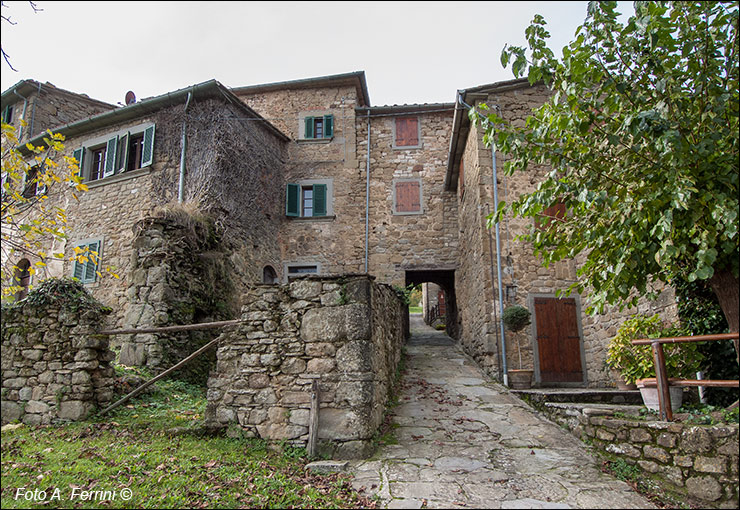Cammino Bizantino nel Comune di Talla
Passeggiata tra Casentino e Valdarno per scoprire testimonianze di questa civiltà
Italiano
DAGLI ETRUSCHI, AI LONGOBARDI, AI TARLATI
Ottocento metri di strada stretta, ma asfaltata, ci hanno condotto da Santo Bagnena a Bagnena, a 585 metri di quota, che avevamo visto a pagina 71 con il panorama da Campovecchio. Un toponimo certamente etrusco, ma quanto potremo osservare c'introduce in un luogo che fu di grande importanza nel medioevo. Troveremo evidenti resti di un castello che non può essere stato solo una fortificazione per il controllo del territorio, ma, per la sua dimensione, anche una sontuosa residenza signorile. Le notizie storiche su Bagnena sono poche, certamente vide i Tarlati come signori del luogo. Ciò ci porta a datare il castello secondo o terzo decennio del XIV secolo, fu questo il periodo che vide il Vescovo Guido Tarlati divenire Signore di Bibbiena e di altre zone del Casentino, a lui successe il fratello Pier Saccone.
Bagnena offre un panorama molto ampio. Questo fu sicuramente il motivo per cui qui fu costruito il castello. È molto probabile, però, che sei-settecento anni prima i longobardi si fossero insediati in questo luogo di così alto valore strategico. L'indizio più indicativo a riguardo è la Chiesa di San Michele Arcangelo che abbiamo visto poco sotto, a Santo Bagnena. Da qui i longobardi potevano ben osservare i bizantini che si trovavano nella vicinissima Campovecchio.
Eight hundred meters of narrow but asphalted road led us from Santo Bagnena to Bagnena, at 585 meters above sea level, which we had seen on page 71 with the view from Campovecchio. An Etruscan toponym, certainly, but what we can observe introduces us to a place that was of great importance in the Middle Ages. We will find clear remains of a castle which may not have only been a fortification to control the territory, but, due to its size, also a sumptuous noble residence. There is little historical information on Bagnena, it certainly saw the Tarlatis as lords of the place. This leads us to date the castle to the second or third decade of the 14th century, this was the period that saw Bishop Guido Tarlati become Lord of Bibbiena and other areas of the Casentino, he was succeeded by his brother Pier Saccone.
Bagnena offers a very broad panorama. This was certainly the reason why the castle was built here. It is very probable, however, that six-seven hundred years earlier the Lombards had settled in this place of such high strategic value. The most indicative clue in this regard is the Church of San Michele Arcangelo that we saw just below, in Santo Bagnena. From here the Lombards could well observe the Byzantines who were in the nearby Campovecchio.






































































































